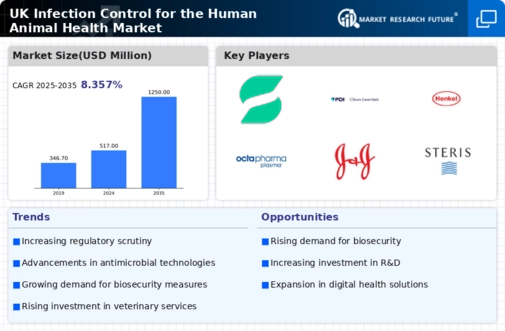Regulatory Compliance and Standards
Stringent regulatory frameworks governing infection control practices are shaping the Global UK Infection Control for the Human Animal Health Market Industry. Compliance with these regulations is essential for healthcare providers and animal health practitioners, driving the adoption of advanced infection control solutions. Regulatory bodies are increasingly emphasizing the need for effective infection prevention strategies, which in turn propels market growth. As the industry adapts to these evolving standards, the market is anticipated to expand, with projections indicating a growth to 5500 USD Million by 2035, highlighting the critical role of compliance in shaping market dynamics.
Global Health Initiatives and Funding
Global health initiatives aimed at improving infection control practices are significantly influencing the Global UK Infection Control for the Human Animal Health Market Industry. Increased funding from governmental and non-governmental organizations supports the development and implementation of infection control programs. These initiatives often focus on enhancing healthcare infrastructure and promoting best practices in infection prevention. As a result, the market is likely to benefit from this influx of resources, contributing to its growth trajectory. The anticipated market value of 3250 USD Million in 2024 underscores the positive impact of global health initiatives on infection control efforts.
Rising Awareness of Infection Control
The Global UK Infection Control for the Human Animal Health Market Industry is experiencing a surge in awareness regarding the importance of infection control measures. This heightened awareness is driven by increased public health campaigns and educational initiatives aimed at both healthcare professionals and the general public. As a result, the demand for effective infection control products and services is expected to rise significantly. In 2024, the market is projected to reach 3250 USD Million, reflecting a growing recognition of the need for robust infection control protocols in veterinary and human health settings.
Increasing Incidence of Zoonotic Diseases
The rising incidence of zoonotic diseases is a critical driver for the Global UK Infection Control for the Human Animal Health Market Industry. As the interaction between humans and animals increases, the potential for disease transmission escalates, necessitating effective infection control measures. This growing concern prompts healthcare providers and animal health professionals to prioritize infection prevention strategies. The market is expected to respond to this challenge by expanding its offerings, thereby contributing to the projected growth to 5500 USD Million by 2035, as stakeholders seek to mitigate the risks associated with zoonotic infections.
Technological Advancements in Infection Control
Innovations in technology are playing a pivotal role in transforming the Global UK Infection Control for the Human Animal Health Market Industry. The development of advanced disinfectants, sterilization equipment, and monitoring systems enhances the efficacy of infection control measures. These technological advancements not only improve the effectiveness of infection prevention strategies but also streamline processes in healthcare and veterinary settings. As the market evolves, the integration of smart technologies is likely to drive growth, with a projected CAGR of 4.9% from 2025 to 2035, indicating a robust future for technologically driven infection control solutions.






















Leave a Comment